When was the last time you licked the plate clean?
In a previous post on sticky toffee cupcakes, I talked about dishes that look ‘too good to eat’. Today it’s the turn of another favourite food expression. While ‘finger licking good’ is a phrase that is sadly slightly tainted (for me anyway) by its association with greasy fast food and a certain white bearded colonel, the idea that something can be so delicious that it makes you want to lick the plate (as well as your fingers) clean is not. It’s appealing and enduring. And something that we all do.
Regardless of whether we’re well versed in table manners or how much our parents shouted at us when we were little, I defy anyone to deny that every once in a while it’s possible to resist putting their face to their plate and licking off that last illicit smear of sauce. I’m often tempted by a plate of pasta or slick of salad dressing, while Carnivorous Boyfriend’s downfall would definitely be gravy, and even if it’s possible to resist face planting into the food, the odd stray finger has been known to find its way in place of a tongue to retrieve those last remaining flecks of flavour.
Before you start to imagine that mealtimes in the little loaf household are some sort of free for all feeding frenzy, I promise this isn’t the case. We’re well aware that licking the plate is something you should limit to the the odd special occasion, at home on your own or with your very nearest and dearest. But that shouldn’t mean anyone should be deprived of those final tempting morsels. And while any sort of over-zealous plate cleaning is never going to be acceptable in the smartest of restaurants, there is a solution we can learn from the Italians for everyday eating when leaving what’s left on your plate just isn’t an option: bread.
Visit any Italian restaurant or home and upon sitting down at the table you’re more than likely to be presented with a big basket of bread. The perfect foil for fruity olive oil, bread is also the ultimate sponge with which to mop up sauces, swiping it across the plate until every last little taste has been allowed its chance to shine. When reading this beautifully written blog the other day, I was delighted to discover that this action is not just an Italian tradition, it actually has a name. Fare la scarpetta (literal translation ‘to do the little shoe’) is an expression used to describe the act of using a morsel of bread to mop your plate clean. While no more acceptable in a formal dining situation than licking the plate (well, perhaps a little), it’s all but compulsory in more relaxed situations, and the perfect way to enjoy your meal to the maximum (as well as an excuse, if ever one was needed, to eat more bread).
Ciabatta is a wonderfully fitting bread with which to do la scarpetta. Literally translated as ‘slipper bread’ on account of its broad, flat shape, the crunchy crust and lovely little holes of ciabatta make it feel like the perfect foodie footwear to dance across your plate. Whether this expression comes from when women would clean the household floors with cloths attached to their feet, or – as blog author Emiko suggests – from the fact that this bread sweeping action was practised by people so poor they would have almost eaten the very soles of their shoes, it’s a charming addition to anyone’s vocabulary and something I’d encourage you to take part in at as many mealtimes as possible.
To make this bread you’ll need to work with a very sticky wet dough, proving it in floured cloths before slinging into a piping hot oven with plenty of steam. The moisture gives the ciabatta its characteristic open texture with lots of lovely air holes, so do respond to your dough and if it feels a little dry (or you’re using a particularly strong flour), add a little more water. This will produce the best texture, and the ultimate little loaf for mopping up all that lovely extra flavour. Licking the plate is the ultimate guilty pleasure, but for when you’re in slightly more polite company, take one for the team and ‘do the little shoe’.
Ciabatta Bread (barely adapted from Dough by Richard Bertinet)
Makes 2 loaves
Make sure to start this recipe 24 hours before you want the bread as the ‘biga’ or ferment needs this long to develop before making the dough.
For the ferment
Ingredients:
175g flour
90g water
1/4 level tsp fresh yeast
Method:
Mix all the ingredients together for about 5 minutes until you have a rough dough. Leave to rest in a bowl covered with cling film for 24 hours.
For the ciabatta
Ingredients:
225g strong white flour
5g yeast
Ferment (see above)
170g water
25g olive oil
7g salt
Method:
Mix together the flour and yeast in a large bowl, rubbing to combine. Add the ferment to your bowl with the water, oil and salt and mix until combined.
Transfer the dough to your work surface using a plastic scraper and knead for approximately ten minutes, or until the dough is soft, light and elastic. It will be very sticky at first but have patience, and definitely don’t be tempted to add any more flour as this will make your loaves dry. Roll the dough into a ball by pressing each edge into the centre and pressing down with your thumb.
Lightly oil a bowl and place the ball of dough inside. Cover with a tea towel and leave to rest for 1 1/2 hours until it has risen and feels bubbly and light.
Flour your work surface and scrape out the dough from its bowl. Flour the top then press the dough down gently before dividing into two equal pieces. Fold each piece into three by folding one side of the flattened dough into the middle and pressing down to seal. Bring the other side over to the middle and again press down to seal. Finally fold it in half lengthways and seal the edges so you have a long loaf shape.
Place the two pieces of dough onto a well floured tea towel, cover with another tea towel and leave to prove for 45 minutes.
Preheat the oven high as it will go. Flour a baking tray or stone. Picking up one ciabatta at a time, turn it over and stretch lengthways at the same time then lay on a baking tray. This will give the loaf its characteristic slipper shape. Slide the loaves onto the baking tray then pop them in the oven, misting the inside with a little water spray to create steam. Turn down the heat to 220 degrees C and bake for about 20 minutes, or until light golden brown.
Remove from the oven and allow to cool. Eat. Enjoy. Do the little shoe.






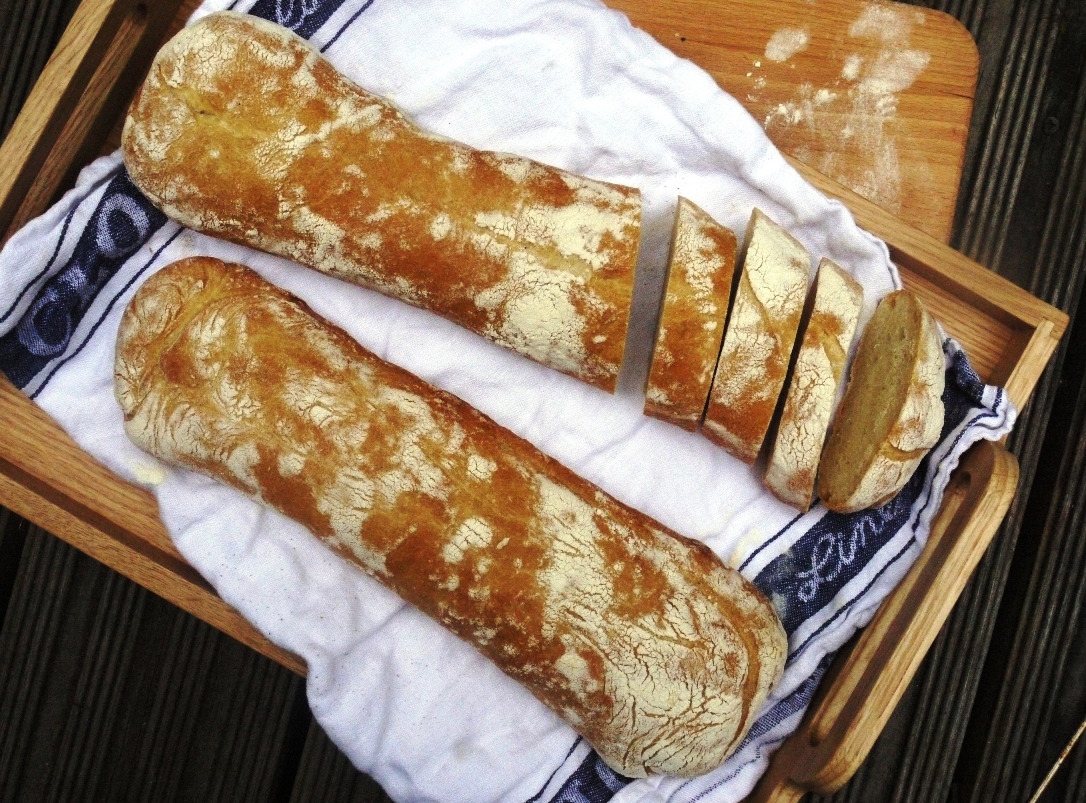
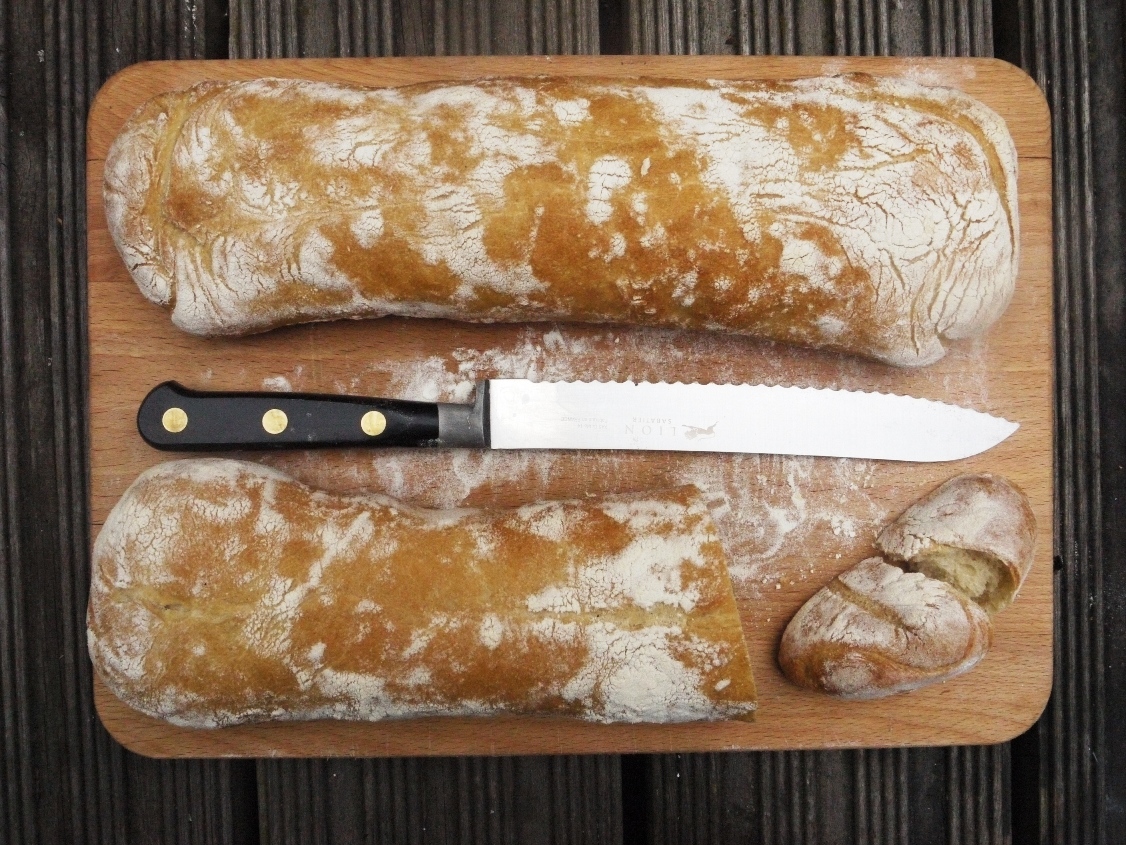
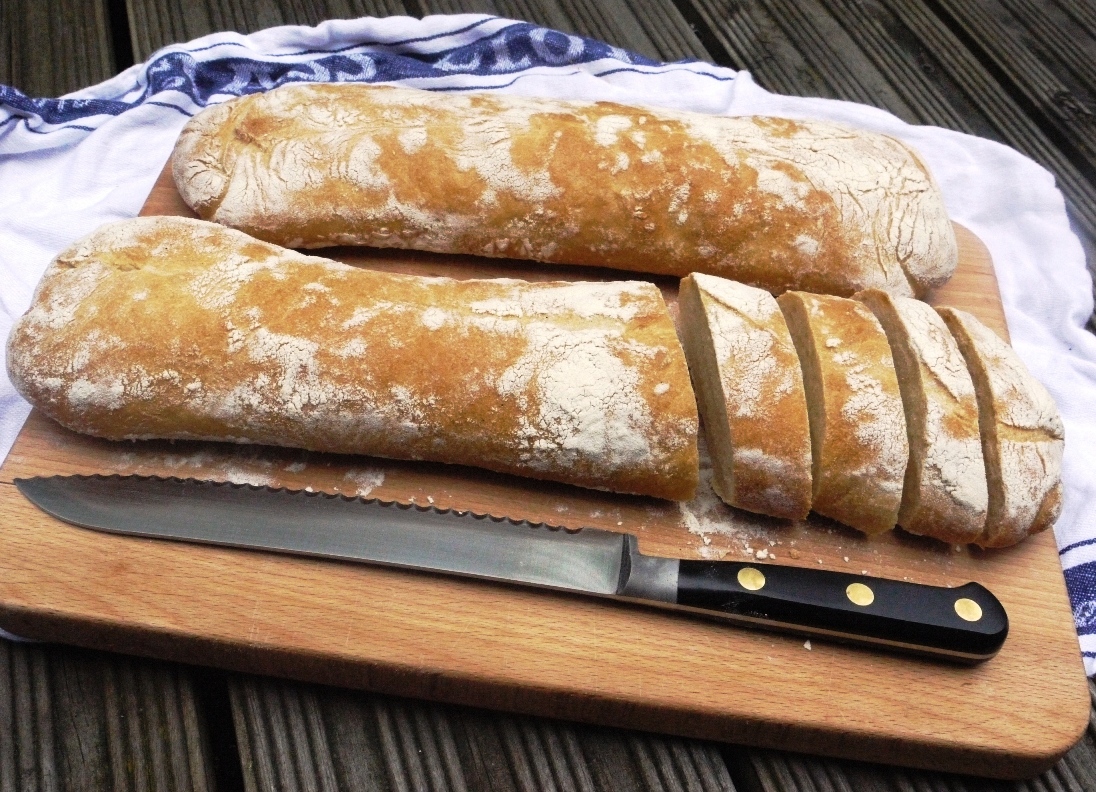
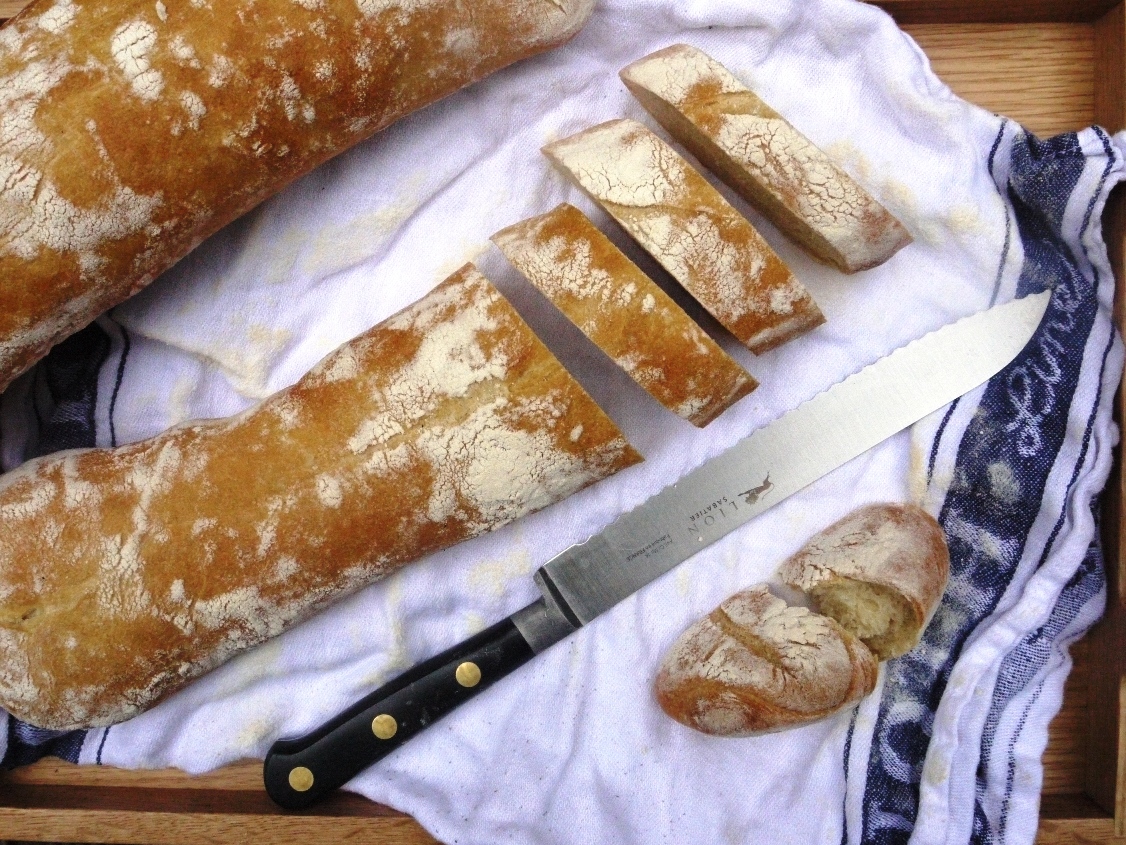
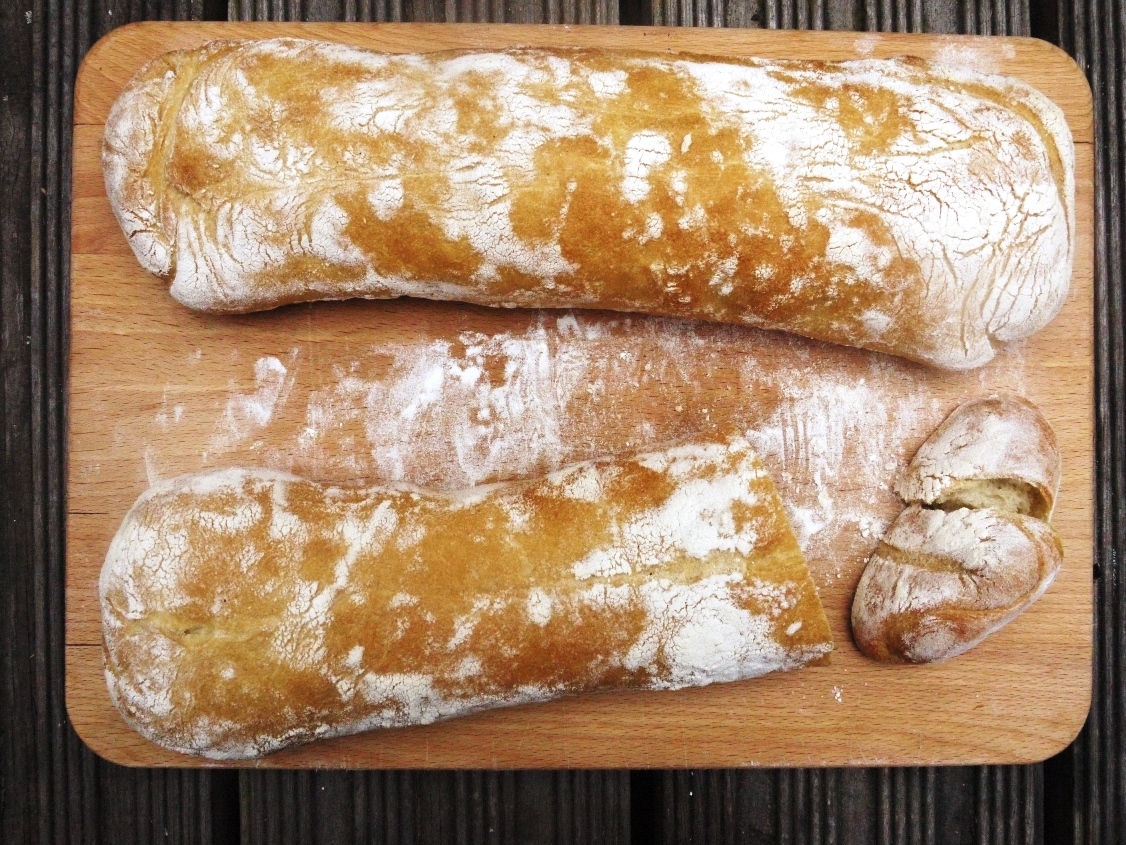
I’m not normally one for licking the plate clean on savoury dishes…but if there are a few smears of chocolate or sticky toffee sauce mixed with some melted ice cream after dessert is finished, I am so there. I’ve never tried making ciabatta, but I think seeing as I have climbed the Everest that is sourdough, I might give it a go! Great post!
How funny! I wrote about the exact same thing and a reader Tina told me about scarpetta too.
Ciabatta is probably my favourite bread to eat but I’ve never tackled it at home – hopefully this post will help me get over that fear! Your photos are gorgeous too.
I’ve never physically licked a plate in my life but have wiped many, many clean with some bready morsel or other! I’m very impressed with the look of your ciabatta as mine spread out an awful lot – again, another recipe given to me by my Italian friend but I’m encouraged to try again using your method to see if it makes the difference. Thanks lil licker! 😉
My husband and I eat a lot of bread at breakfast, sometimes finishing a loaf or more between the two of us in just one sitting! When we were living in the US, it was really hard to find good bread, something that tasted wholesome and wasn’t full of sugar. Thankfully, we stumbled across the ciabatta at Whole Foods and it remained the *only* bread we ever ate in the US. You would think we would have been sick of it after 2 years, but we still love it. Now that we are back in Switzerland, next door to Italy, it’s rather funny that ciabatta is nowhere to be found! So I might give this a try at home. Thanks for the recipe!
Your ciabatta looks fabulous … never tried to make it but maybe how I will.
Elly – ooh yes, licking the plate with puddings is pretty much compulsory!
Lorraine – I love the idea of ‘la scarpetta’, it makes me so happy 🙂
Kathryn – thank you!
Jo – do give this recipe a try, it worked really well first time 🙂
Eat Little Bird – it’s so hard to find good bread in US supermarkets. Actually in UK supermarkets too, that’s why I prefer to make my own!
The Single Gourmet & Traveller – you definitely should give it a go!
What could be better than beautiful fresh bread and olive oil or sauce. Perfect
http://www.mykitchenstories.com.au
Ciabatta is one of my favourite breads and you have mastered it so very well. I like the idea of giving this a go as I do find kneading doughs so relaxing and I love it when you get past the stage of it being very sticky to suddenly coming together into a lovely soft dough.
Beautiful photos to accompany this post too!
Yay, ciabatta bread! This is definitely reminding me that I need to break out my baking equipment soon. 🙂
Wow! What beautiful ciabatta. I’ve always wanted to make it but have been nervous from that wet & sticky dough. Thanks for the help and motivation. 🙂
Your loaves turned out beautifully! I’m inspired to give it a try.
gah! this is all so beautiful, from the recipe to the photos. you never cease to amaze with me lovely! x
My Kitchen Stories – very little!
Laura – thank you 🙂 It is so satisfying seeing your dough come together. Hope you enjoy the bread if you get around to making it!
Eileen – do it!
Amy – thank you, and my pleasure 🙂
Marissa – thanks!
Elaina – aw, thank you 🙂
Your ciabatta looks wonderful – hubby has tried many times to make it but without great results (yet!). So glad my scarpetta post inspired some plate-wiping activity! Thanks for this great post!
I’m back! I love ciabatta and even though doing “scarpetta” was always a no-no growing up and still is now because we are trying to set an example for our own offspring, it cannot always be resisted. Especially when in presence of oil, garlic and tomato sauce! Can I grab a piece of yours?
Looks absolutely fabulous!
This looks fabulous! Can I substitute dry yeast, and what is “strong” white flour? thanks much…
Mmm. I love ciabata! I need to try this asap.
holy smokes! that picture is amazing! I am missing the crunch and chew of a good loaf of bread! MMM!
Emiko – thanks for the inspirational post in the first place! Love visiting your blog 🙂
Nuts About Food – you are too good! I don’t yet have kids, but can imagine I’d find it hard to resist in front of them…
Andrea – thank you.
Karen – strong white bread flour has a high gluten content which makes it good for bread baking. And you should be able to substitute dry yeast in this recipe just fine.
Russell – thank you, do give it a go, it’s so delicious!
Linda – thank you 🙂
Ciabattas make the best sandwiches with their crustiness and small amount of crumb. Keep the bread recipes coming. You have such a good blog!
I’m maintaining an embarrassed silence about that plate licking tendency! Much more refined to use some of your delicious looking ciabatta 😉
Vintage Kitchen Notes – thank you so much 🙂 Will definitely be posting more bread recipes soon.
Choclette – haha, I may have exaggerated slightly for this post – I don’t lick the plate all the time (promise…) 🙂
Gorgeous – it’s a work of art!
What a good post, I feel like I could make this and believe I will, I’ve always loved ciabatta bread.
P.S. My husband licks his plate quite frequently 😉 It’s not that uncommon…
Thank you so much 🙂 Hope you get around to making your own ciabatta soon.
Pingback: Caramelized Brown Bread & Pecan Ice Cream | thelittleloaf
Pingback: Grub In A Jiffy For The Workers! - Rocking Dog
Some really interesting details you have written.Helped me a lot, just what I was searching for :D.